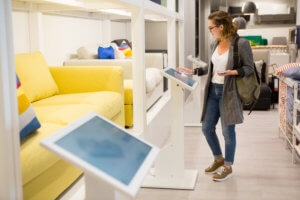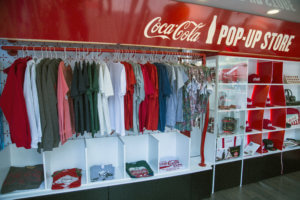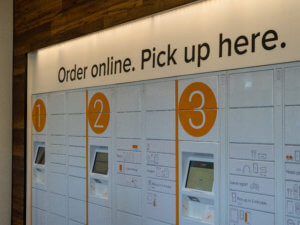Recent years have seen a spike in the number of retail stores that are closing down. In 2017, there was a record-setting estimate of approximately 102 million square feet of retail space that went out of business.
Retailers worldwide are facing significant challenges, and the main culprit is the internet. We live in a world that is becoming more and more focused on the digital experience, and this has altered the way we carry out most of our everyday tasks. From internet shopping to smart homes, smartphones and smart TVs, there is no aspect of life that is untouched by the internet, and the tools and culture that surround it. Look no further than online retail mammoth Amazon to find an example. Beyond online shopping, Amazon is advancing the concept of “microtrips” - in-store shopping trips that take 5 minutes or less. This is enabled by Amazon Lockers, the parcel pick up service available in Whole Foods stores, as well as Amazon Go - a totally tech-based, no lines, no checkout retail store concept.
When it comes to retail technology, if you can’t beat ‘em, join ‘em . Retailers around the world are looking for ways to boost customer engagement and sales in store - and, there is a wide range of current and emerging technologies designed to provide the answer.
Here’s three interesting retail trends that are changing the consumer experience in the traditional retail store.
AR/VR
Virtual reality and augmented reality enable retailers to bridge the online digital world with the brick-and-mortar store experience. For example, with VR and AR, customers can “try on” a range of products virtually, before deciding to purchase. The popular beauty brand Sephora introduced Virtual Artist, a 3D AR experience where customers can upload a photo of themselves and try different shades of lipstick and other makeup products, simulating how they would look in real life.
Another example is IKEA, the global homewares giant, who developed an AR based app for customers to “try before they buy”. The IKEA Place app, which became available to Android users last year, enables customers to virtually position IKEA furniture pieces in their own home, so they can see how the piece fits before purchasing. Many more retailers are adopting AR-based apps to engage customers and enhance the consumer experience. In this way, technology is not replacing the retail experience - rather, true to its name, it is “augmenting” it.

Pop-up stores
Pop-up stores are not a brand new phenomenon, but they are predicted to take an even greater hold this year. Pop-up stores are small, temporary stores that retailers can set up in a range of locations for different purposes. A major advantage of pop-up stores is the lower overheads than permanent stores, due to reduced rent, staffing and utilities costs. However the real benefit of pop-up stores for retailers is the ability to strengthen customer connections, experiment with new concepts and audiences, and boost specific products or campaigns.
For example, Nike recently opened a pop-up store in Atlanta exclusively for users of its SNKRS app. The store, which was built just in time for the 2019 Super Bowl in Atlanta, used geo-fencing technology to send mobile push notifications in real time to people located within a 25-mile radius of Atlanta. The notifications included special offers, such as the chance to buy limited edition products, or to unlock access to exclusive products available in the pop-up store.
Cosmetics company Clinique opened a pop-up store in New York especially to promote one particular product, its Clinique iD moisturizer. The temporary 10-day store offered an immersive experience for customers, with a consultation bar where they could take a skin quiz to establish their unique skin needs. They then created their ideal moisturizer combination from a possible 15 options, with three types of available bases and five different concentrations. There was also a virtual reality experience featuring marketing influencers, and although the pop-up store was dedicated to the Clinique iD product, customers could order other Clinique products and have them shipped to their home address.
Pop-up stores in their temporary nature enable this kind of experimentation and customization according to short term marketing strategies, and have so far proven very beneficial to retailers in many industries.

Omnichannel experience
Merging the digital customer experience with the physical experience encountered in store is critical to building stronger relationships with customers. When the online and offline channels come together, it is called an “omnichannel” experience
A popular method is “Buy Online. Pick Up In Store”, which enables retailers to leverage the online sales process to create an in-store encounter. When customers come in to the store to pick up their order, it is the perfect opportunity for retailers to tempt them with complementary products and purchases.
Another way to bring the online experience to the brick-and-mortar store is the use of touchscreens and apps, including online checkout, virtual aisles and customized product suggestions, push notifications sent to customers’ mobile phones during their store visit, as well as in-store digital tools to enhance the customer’s knowledge of the product.
These new approaches are not about technology alone; rather they provide customers with opportunities to continue their journey with the retailer, while they are in the store and even after they leave.
![]()
![]()

Retail technologies are not just a tool; they are a connector - between the online and in-store experience, between the retailer and the customer, between the brand the the consumer - helping to drive engagement and sales. This is the true purpose of “omnichannel” marketing, and it is not the future - it’s here today.




-1.jpg?width=310&name=blog_image%20(003)-1.jpg)





